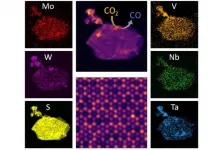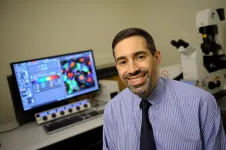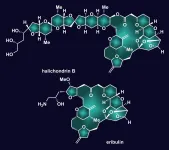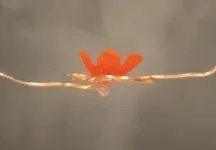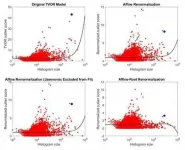(Press-News.org) A two-dimensional alloy material -- made from five metals as opposed to the traditional two -- has been developed by a collaboration between researchers at the McKelvey School of Engineering at Washington University in St. Louis and researchers at the College of Engineering at the University of Illinois at Chicago.
And, in a first for such a material, it has been shown to act as an excellent catalyst for reducing CO2, into CO, with potential applications in environmental remediation.
The research, from the lab of Rohan Mishra, assistant professor in the Department of Mechanical Engineering & Materials Science at Washington University, was published Saturday, June 26, in the journal Advanced Materials.
"We're looking at transforming carbon dioxide, which is a greenhouse gas, into carbon monoxide," Mishra said. "Carbon monoxide can be combined with hydrogen to make methanol. It could be a way to take CO2 from the air and recycle it back into a hydrocarbon."
The basis of this innovation is a class of materials known as transition metal dichalcogenides (TMDCs) -- they include transition metals and a chalcogen, which includes sulfur, selenium and tellurium. When an alloy contains more than three metals at near equal ratios, it's said to be "high entropy." Hence the wordy name of the material developed in Mishra's lab: high-entropy transition metal dichalcogenides.
TMDCs are not new. There has been interest in similar two-dimensional forms of these materials due to their unique optical and electronic properties, Mishra said. But he had a suspicion they could be used for something else.
"We've been looking at these, too, but exploring their potential for electrocatalysis," acting as a catalyst to facilitate chemical reactions. As they are effectively two-dimensional (about three atoms thick), they make for efficient catalysts; reactions occur on the surface of a material, and a two-dimensional material has a lot of surface area, and not much else. In an earlier study, also published in the journal Advanced Materials in 2020, the group had shown that two-metal TMDC alloys showed improved catalytic activity over individual TMDCs. "This led us to the question, can adding more metals to these alloys make even better catalysts?" Mishra said.
With 10 applicable transition metals and three chalcogens, there are 135 two-metal and 756 five-metal possible TMDC alloys. However, just like oil and water, not all combinations will mix together to form a homogenous alloy.
"Without guidance from computations, experimentally determining which elemental combinations will give an alloy becomes a trial-and-error process that is also time consuming and expensive," Mishra explained.
The alchemist in this case was John Cavin, a graduate student in Washington University's Department of Physics in Arts & Sciences.
In the previous work, Cavin had shown which two transition metals can be combined, and at what temperatures, to form binary TMDCs alloys.
"The question was, 'Could we even synthesize a TMDC alloy that had that many components?'" Cavin said. "And will they improve the reduction of CO2 into CO?"
To find out, he used quantum mechanical calculations to predict which combinations were most likely to improve the material's ability to catalyze CO2. Then he had to go further to determine if the material would be stable, but had no tools to do so. So, he developed one himself.
"I had to develop a thermodynamic model for predicting stable high-entropy TMDC alloys from the quantum mechanical calculations," Cavin said. These calculations were carried using considerable supercomputing resources, made available by the Extreme Science and Engineering Discovery Environment network, which is supported by the National Science Foundation.
After years of development, the resulting analysis was sent to experimental collaborators at the University of Illinois at Chicago.
"At UIC, they could synthesize the materials that we predicted would form a high-entropy TMDC alloy," Mishra said. "Furthermore, one of them showed exceptional activity."
They may have other uses, too. UIC synthesized three of the four different TMDC alloys and will continue to analyze them.
"These are new materials, they have never before been synthesized," Mishra said. "They may have unanticipated properties."
The work stems from a DMREF grant from the National Science Foundation as part of the Materials Genome Initiative launched by President Barack Obama in 2011 as a multi-agency initiative to create policy, resources and infrastructure that support U.S. institutions to discover, manufacture and deploy advanced materials efficiently and cost-effectively.
INFORMATION:
A team of neuroscientists at the Beckman Institute for Advanced Science and Technology led by Baher Ibrahim and Dr. Daniel Llano published a study in eLife that furthers our understanding of how the brain perceives everyday sensory inputs.
"There is a traditional idea that the way that we experience the world is sort of like a movie being played on a projector. All the sensory information that is coming in is being played on our cerebral cortex and that's how we see things and hear things," said Llano, a Beckman researcher and associate professor in the Department of Molecular and Integrative Physiology at the University of Illinois ...
Many drivers use tollways to get from point A to point B because they are a faster and more convenient option. The fees associated with these roadways are higher during peak traffic hours of the day, such as during the commute to and from work. With this structure, drivers who are not adding to the heavy flow of traffic do not have to pay higher toll prices. However, those who utilize the toll road during more congested hours pay a premium to use the faster, more convenient highways.
Similarly, not everyone uses the same amount of electricity throughout the day. There are peak load hours that put more strain on the grid, and there are users within those times who use more electricity ...
HOUSTON - (June 29, 2021) - The story of halichondrin B, an inspirational molecule obtained from a marine creature, goes back to the molecule's discovery in an ocean sponge in 1986.
Though it has been replicated in the laboratory several times before, new work by Rice University chemists could make halichondrin B and its naturally occurring or designed variations easier to synthesize.
Synthetic chemist K.C. Nicolaou and his lab reported in the Journal of the American Chemical Society their success in simplifying several processes used to make halichondrin B and its variations.
Halichondrin's molecular structure and potent antitumor ...
Dark Energy is widely believed to be the driving force behind the universe's accelerating expansion, and several theories have now been proposed to explain its elusive nature. However, these theories predict that its influence on quantum scales must be vanishingly small, and experiments so far have not been accurate enough to either verify or discredit them. In new research published in EPJ ST, a team led by Hartmut Abele at TU Wien in Austria demonstrate a robust experimental technique for studying one such theory, using ultra-cold neutrons. Named 'Gravity Resonance Spectroscopy' (GRS), their approach could bring researchers ...
Scientists have discovered how plants manage to live alongside each other in places that are dark and shady.
Moderate shade or even the threat of shade - detected by phytochrome photoreceptors - causes plants to elongate to try to outgrow the competition.
But in the deep gloom of a dense forest or a cramped crop canopy where resources and photosynthesis are limited, this strategy doesn't work. In these conditions it would be a waste of energy and detrimental to survival to elongate stems because seedlings would never be able to over-grow larger neighbours.
So how do plants prevent elongated growth under deep shade conditions? The secret lies in their internal clocks, says the research collaboration from the John Innes Centre ...
NEW YORK (June 29, 2021)--In a new paper published in the journal Vaccine: X, public health experts from Columbia University Mailman School of Public Health, the University of Oslo, and Spark Street Advisors highlight actions to accelerate access to vaccines globally. The paper reviews the vaccine research and development process and proposes areas where reforms could increase access, speed time to market and decrease costs--from R&D to manufacturing and regulation to the management of incentives like patents and public funding.
The COVID-19 ...
A process that uses heat to change the arrangement of molecular rings on a chemical chain creates 3D-printable gels with a variety of functional properties, according to a Dartmouth study.
The researchers describe the new process as "kinetic trapping." Molecular stoppers--or speed bumps--regulate the number of rings going onto a polymer chain and also control ring distributions. When the rings are bunched up, they store kinetic energy that can be released, much like when a compressed spring is released.
Researchers in the Ke Functional Materials Group use heat to change the distribution of rings and then use moisture ...
DURHAM, N.C. - Combining structural biology and computation, a Duke-led team of researchers has identified how multiple mutations on the SARS-CoV-2 spike protein independently create variants that are more transmissible and potentially resistant to antibodies.
By acquiring mutations on the spike protein, one such variant gained the ability to leap from humans to minks and back to humans. Other variants -- including Alpha, which first appeared in the United Kingdom, Beta, which appeared in South Africa, and Gamma, first identified in Brazil - independently developed spike mutations that enhanced their ability to spread rapidly in human ...
Aerospace engineering faculty member Melkior Ornik is also a mathematician, a history buff, and a strong believer in integrity when it comes to using hard science in public discussions. So, when a story popped up in his news feed about a pair of researchers who developed a statistical method to analyze datasets and used it to purportedly refute the number of Holocaust victims from a concentration camp in Croatia, it naturally caught his attention.
Ornik is a professor in the Department of Aerospace Engineering at the University of Illinois Urbana-Champaign. He proceeded to study the research in depth and used the method to re-analyze the same data from the United ...
ROCHESTER, Minn. -- Mayo Clinic researchers are taking a close look at rare cases of inflammation of the heart muscle, or myocarditis, in young men who developed symptoms shortly after receiving the second dose of the Moderna or Pfizer messenger RNA (mRNA) COVID-19 vaccines. Several recent studies suggest that health care professionals should watch for hypersensitivity myocarditis as a rare adverse reaction to being vaccinated for COVID-19. However, researchers stress that this awareness should not diminish overall confidence in vaccination during the current pandemic.
While reports of post-vaccine myocarditis ...
